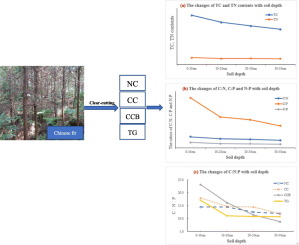当前位置:
X-MOL 学术
›
Sci. Total Environ.
›
论文详情
Our official English website, www.x-mol.net, welcomes your
feedback! (Note: you will need to create a separate account there.)
Effects of different management approaches on the stoichiometric characteristics of soil C, N, and P in a mature Chinese fir plantation.
Science of the Total Environment ( IF 8.2 ) Pub Date : 2020-03-26 , DOI: 10.1016/j.scitotenv.2020.137868 Yanfeng Bai 1 , Shiyou Chen 2 , Shuorong Shi 2 , Mengjuan Qi 2 , Xiuhong Liu 2 , Hui Wang 2 , Yixiang Wang 3 , Chunqian Jiang 1
Science of the Total Environment ( IF 8.2 ) Pub Date : 2020-03-26 , DOI: 10.1016/j.scitotenv.2020.137868 Yanfeng Bai 1 , Shiyou Chen 2 , Shuorong Shi 2 , Mengjuan Qi 2 , Xiuhong Liu 2 , Hui Wang 2 , Yixiang Wang 3 , Chunqian Jiang 1
Affiliation

|
Carbon (C), nitrogen (N), and phosphorus (P) are commonly used to evaluate soil quality. However, still little is known about the effects of human activities on soil C, N, and P. In this study, we compared the stoichiometric characters of soil C, N, and P in a mature Chinese fir (C. lanceolata) plantation under four forest management approaches: uncut as a control (NC), clear-cutting (CC), controlled burning after clear-cutting (CCB) and conversion into a tea garden (TG). We measured the total C (TC), total N (TN), and total P (TP) contents and evaluated the ratios of C:N, C:P, N:P, and C:N:P in each treatment. The results showed that: (1) the contents of TC and TN in all management approaches decreased with increasing soil depth, while the TP content in NC, CC, and CCB decreased at first, then increased. More importantly, there was no significant difference in TP content under the four management approaches. (2) The ratios of C:N, C:P, N:P, and C:N:P decreased with increasing soil depth. Interestingly, the ratio of C:N was lower than that of C:P in every management approach. (3) Despite the different management approaches (NC, CC, CCB, and TG), the ratios of soil C:N:P were relatively stable, which were 24:4:1, 26:4:1, 21:3:1, and 21:3:1, respectively. CCB showed the greatest negative effect on soil TC, TN, and TP contents, suggesting it might be beneficial to avoid this approach for Chinese fir management.
中文翻译:

不同管理方式对杉木人工林土壤碳,氮和磷化学计量特征的影响。
碳(C),氮(N)和磷(P)通常用于评估土壤质量。但是,关于人类活动对土壤C,N和P的影响知之甚少。在这项研究中,我们比较了C.N.和P.C.杉木成熟下人工林土壤C,N和P的化学计量特征。四种森林管理方法:未砍伐为对照(NC),伐木(CC),伐木后的可控燃烧(CCB)以及转化为茶园(TG)。我们测量了总C(TC),总N(TN)和总P(TP)含量,并评估了每种处理中C:N,C:P,N:P和C:N:P的比率。结果表明:(1)所有管理方式中TC和TN的含量均随土壤深度的增加而降低,而NC,CC和CCB中的TP含量先降低后升高。更重要的是,四种管理方法下总磷含量没有显着差异。(2)C:N,C:P,N:P和C:N:P的比例随土壤深度的增加而降低。有趣的是,在每种管理方法中,C:N的比率都低于C:P的比率。(3)尽管采取了不同的管理方式(NC,CC,CCB和TG),但土壤C:N:P的比例相对稳定,分别为24:4:1、26:4:1、21:3: 1和21:3:1。CCB对土壤中TC,TN和TP含量表现出最大的负面影响,表明避免这种方法对杉木的管理可能有益。(3)尽管采取了不同的管理方式(NC,CC,CCB和TG),但土壤C:N:P的比例相对稳定,分别为24:4:1、26:4:1、21:3: 1和21:3:1。CCB对土壤中TC,TN和TP含量表现出最大的负面影响,表明避免这种方法对杉木的管理可能有益。(3)尽管采取了不同的管理方式(NC,CC,CCB和TG),但土壤C:N:P的比例相对稳定,分别为24:4:1、26:4:1、21:3: 1和21:3:1。CCB对土壤中TC,TN和TP含量表现出最大的负面影响,表明避免这种方法对杉木的管理可能有益。
更新日期:2020-03-27
中文翻译:

不同管理方式对杉木人工林土壤碳,氮和磷化学计量特征的影响。
碳(C),氮(N)和磷(P)通常用于评估土壤质量。但是,关于人类活动对土壤C,N和P的影响知之甚少。在这项研究中,我们比较了C.N.和P.C.杉木成熟下人工林土壤C,N和P的化学计量特征。四种森林管理方法:未砍伐为对照(NC),伐木(CC),伐木后的可控燃烧(CCB)以及转化为茶园(TG)。我们测量了总C(TC),总N(TN)和总P(TP)含量,并评估了每种处理中C:N,C:P,N:P和C:N:P的比率。结果表明:(1)所有管理方式中TC和TN的含量均随土壤深度的增加而降低,而NC,CC和CCB中的TP含量先降低后升高。更重要的是,四种管理方法下总磷含量没有显着差异。(2)C:N,C:P,N:P和C:N:P的比例随土壤深度的增加而降低。有趣的是,在每种管理方法中,C:N的比率都低于C:P的比率。(3)尽管采取了不同的管理方式(NC,CC,CCB和TG),但土壤C:N:P的比例相对稳定,分别为24:4:1、26:4:1、21:3: 1和21:3:1。CCB对土壤中TC,TN和TP含量表现出最大的负面影响,表明避免这种方法对杉木的管理可能有益。(3)尽管采取了不同的管理方式(NC,CC,CCB和TG),但土壤C:N:P的比例相对稳定,分别为24:4:1、26:4:1、21:3: 1和21:3:1。CCB对土壤中TC,TN和TP含量表现出最大的负面影响,表明避免这种方法对杉木的管理可能有益。(3)尽管采取了不同的管理方式(NC,CC,CCB和TG),但土壤C:N:P的比例相对稳定,分别为24:4:1、26:4:1、21:3: 1和21:3:1。CCB对土壤中TC,TN和TP含量表现出最大的负面影响,表明避免这种方法对杉木的管理可能有益。











































 京公网安备 11010802027423号
京公网安备 11010802027423号